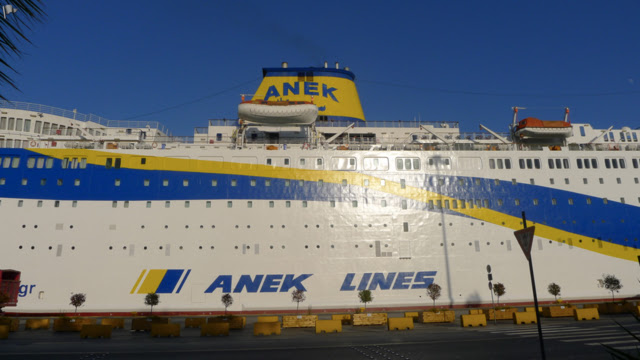Since my early childhood days, I have always enjoyed ferries, whether passenger or car ferries. My first experience was with the Mersey Ferries, of which the Royal Iris was my favorite when we went out once or twice a year.
 |
| Royal Iris in its original colors |
 |
| In its later colors in front of the Liver Building |
Car ferries always had a fascination for me, especially this one in Southern Chile.........
But I digress from the subject of this blog - Greek Ferries.
By far the most famous of Greek ferries is the Styx ferry operated from time immemorial by Charon,
as he goes back and forth ferrying the dead to the underworld (if, and only if, they have the means to pay).
We found the somewhat more modern ferries were a great way to get around on our recent visit to Greece and in general they were both comfortable and reasonably priced.
We started out with a ferry from Piraeus, the busy port of Athens.
We were on a very large ferry with many trucks and cars for the overnight trip to Chania in Crete. We have found that these overnight ferries are very convenient - they leave in the late evening and arrive in the early morning. They have a good restaurant and we had a small but comfortable two-bedded cabin.
The interior was almost as dramatic.
It can carry 600 passengers and 125 cars. It travels very comfortably at 55 kilometres per hour (35 miles per hour).
So we went on the Artemis, which is large, carrying 1,250 passengers and 85 cars. Fortunately, they were very few passengers and we were able to sit on seats outside (still a little windy as it goes at 20 mph (32 kph).
We cruised within the Santorini group of islands, passing lots of volcanic scenes....
 |
| Solidified Lava Flow |
 |
| Layers from successive eruptions. |
.... before arriving at the island of Therasia.
This seemed a rather strange port of call for a ferry that could carry five times the island's population, but there is probably a good (political?) reason. One passenger did get on.
We then went on to Karavostasis, the port for the much larger island of Folegrandos with its three villages and a population of 667.
Next port of call was the island of Sikinos (population 238).
As was mentioned by Gallivanting Isadora we had seen this intriguing advertisement in a shop window in Athens...
... so we were on the lookout to see if we could find it. We passed several potential candidates like this one....
.... but decided that the price seemed to be aimed at tourists, as everywhere on the island has a seaview and there seemed to be nothing resembling a garden!
Our penultimate stop for the day was Naxos. According to Herodatus, this was the most prosperous of the Aegean islands. Even today it looks prosperous and much more like a city than any of the other places we visited.
Finally, after nearly seven hours of travel we arrived the destination for the day - Paros - whose tourist office is in the windmill at the entrance to the port. We had had a great day, with plenty of fresh air, magnificent views and a great appreciation for the similarity of the semi-arid islands. One minor point that should be mentioned is that the food available on the ship was the Greek equivalent of fast-food - possibly marginally nutritious but definitely not tasty.
 |
| Paros Tourist Office |
Again we had a very comfortable ride.
For the sake of completeness, I should add the ride we had from Mykonos to Delos on the Orca - this was a very conventional but adequate ferry that took us to Delos and back. I will have much more to say about Delos in a later blog - it was truly a high point in our travels.
After that it was back to the mainland but to an alternative to Piraeus as a port for Athens. Rafina is much smaller but is more convenient to the airport (after an interesting taxi ride with a driver that knew all the short cuts, whether paved or not!). We travelled on the SeaJet 2 which can hold almost 400 passengers at about 70 kilometres per hour. We stopped en route at Tinos, and for the first time in our travels the boat almost completely filled to capacity.
 |
| The interior of the SeaJet 2 - 14 or 16 seats across - wide and with plenty of leg room. |
Leaving the subject of Ferries we need to end on a down note - the Royal Iris is now rotting on the side of the Thames at Woolwich - a real blow to my schoolboy memories.












































